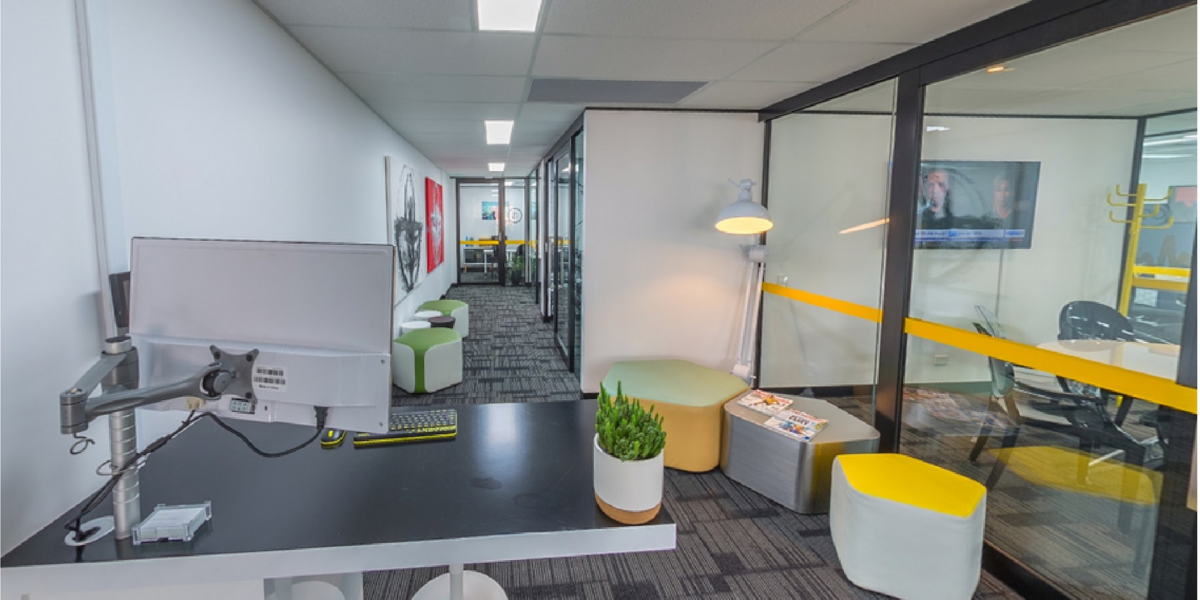A Deep Dive with Anytime Offices into Productivity, Sustainability, and Employee Well-Being
The COVID-19 pandemic led to a radical shift from traditional work environments towards remote working worldwide. As organisations ready themselves for the post-pandemic era, the benefits of hybrid work structures are being increasingly recognised. This article delves into the advantages of hybrid work models and illustrates the solutions that Anytime Offices bring to the table for an efficient and flexible hybrid workplace.
Definition of Hybrid Work Structure
A hybrid work model is a flexible approach that allows staff members to divide their work hours between the office and a remote location. This model can be tailored to suit the specific needs of each organisation and its employees, fostering a dynamic and adaptable work environment.
Benefits of Hybrid Work Structures
-
Enhanced Productivity
Hybrid work models can lead to a significant improvement in productivity. A study by the Boston Consulting Group suggests that employees with the freedom to choose their work location report heightened levels of productivity. This is ascribed to fewer distractions, a work environment that can be personalised, and improved balancing of personal and professional responsibilities.The claim that a hybrid work model can increase productivity is not merely anecdotal; it’s backed by a growing body of research and real-world examples. Let’s break down some of the key factors contributing to this uptick in productivity.
Reduced Commute Time
One of the most immediate benefits employees experience in a hybrid work model is the elimination or reduction of daily commuting. Commuting can be both time-consuming and mentally exhausting, often setting a stressful tone for the rest of the day. Removing this aspect even a few days a week allows for a more relaxed start, enabling employees to focus on work tasks more quickly and efficiently.
Custom Work Environments
A hybrid work structure allows employees to tailor their work environments to suit their needs. Some people find they’re more productive in a quiet, isolated space, which they can easily set up at home. Others may prefer the structure and resources available in a traditional office setting for certain tasks. Having the freedom to choose allows employees to work in the environment most conducive to their productivity.
Autonomy and Responsibility
The autonomy associated with choosing when and where to work often leads to increased feelings of responsibility. Employees become more accountable for their time management and the quality of their work, leading to a more proactive and focused approach to tasks.
Improved Mental Health
The flexibility of a hybrid work model can result in improved mental health, as it allows for a better work-life balance. Happier employees are generally more productive, as they have the mental space to innovate, solve problems, and focus on their work.
Streamlined Communication
In a hybrid model, companies often invest in robust digital communication tools to keep the team connected. These platforms can make meetings more efficient, facilitate quicker decision-making, and ensure that essential information is easily accessible to all team members, irrespective of their location.
Task Optimisation
Being in the office is often crucial for tasks that require close collaboration, access to specific tools, or hands-on training. Working from home can be more efficient for focused tasks, research, or writing assignments. A hybrid model allows employees to plan their weeks around the types of tasks they have, optimising their time and thereby increasing productivity.
-
Better Work-Life Balance
The concept of a better work-life balance has become more than just a catchphrase; it’s now a metric for gauging employee satisfaction and overall well-being. In a hybrid work structure, this balance is not merely an aspiration but a tangible reality for many. Let’s examine the facets contributing to an improved work-life balance.
Flexibility in Scheduling
A hybrid work model offers the latitude for employees to manage their work hours more effectively, which can be a godsend for those juggling family responsibilities, educational pursuits, or even just personal hobbies. This flexibility allows for a more personalised work schedule, making it easier to integrate work commitments with personal life.
Less Stress.More Time
Eliminating or reducing the daily commute can dramatically cut down on stress and free up valuable time. This
extra time can be redirected towards personal pursuits, be it physical exercise, spending time with family, or personal development, thus enriching one’s quality of life.
Mental Well-Being
The autonomy to choose one’s work environment and, by extension, to have more control over one’s daily life can significantly improve mental health. Reduced stress levels and better mental well-being are crucial factors in achieving a balanced life, and they contribute to increased productivity and job satisfaction as well.
Increased Family Time
For those with families, the ability to work from home part of the time often means more moments spent with loved ones. Whether it’s being able to take a lunch break with your partner or being home when the kids return from school, these small increments of family interaction can make a big difference in life satisfaction.
Opportunity for ‘Me Time’
While family is important, the flexibility afforded by a hybrid work model also allows for valuable ‘me time.’ Whether it’s an hour spent reading, a quick run during a lunch break, or even just the peace of meditating in a familiar environment, these moments of solitude contribute to a well-rounded life.
Avoiding Burnout
A well-balanced work-life equation is essential in avoiding job burnout, which has seen a worrying increase in recent years. Thehybrid work model offers a safety valve, allowing employees to switch between different work environments and thus alleviate the risk of burnout.
-
Employee Satisfaction, Talent Attraction and Retention
In today’s competitive business landscape, talent retention and attraction have become pivotal factors for an organisation’s long-term success. Companies are now recognising the transformative impact that a hybrid work model can have on these fronts. Below, we explore the ways in which hybrid working structures can significantly enhance your company’s ability to retain existing talent and attract new high-calibre professionals.
Meeting Employee Expectations
The modern workforce increasingly values flexibility, autonomy, and a supportive work-life balance. A hybrid work model caters directly to these desires, thereby increasing employee satisfaction and loyalty. In essence, by giving people what they want, you make them less likely to look for opportunities elsewhere.
Broadening the Talent Pool
A hybrid work model isn’t just about retaining the talent you already have; it’s also about attracting new talent. The flexibility inherent in this work structure expands the geographical limitations traditionally associated with recruitment. You can attract high-quality talent from virtually anywhere, not just within commuting distance of your office.
Branding and Company Image
Adopting a hybrid model can enhance your brand image, signalling that your organisation is progressive, adaptive, and mindful of employee well-being. This reputational boost can make your company more attractive to job seekers looking for a modern, flexible work environment.
Reduced Turnover Costs
High employee turnover is not only disruptive but also expensive. Recruitment costs, training new employees, and the productivity dip during these transitional periods can impact your bottom line. By offering a more flexible, employee-centric work environment, you can significantly reduce turnover and its associated costs.
Work-Life Harmony as a Selling Point
Promoting a better work-life balance isn’t just an internal policy; it’s a selling point that can distinguish your company in the job market. Prospective employees looking to achieve a better balance between their professional and personal lives may see your organisation as an ideal fit, thereby increasing the quality of your talent pool.
Employee Engagement and Productivity
Employees who are content with their work conditions are likely to be more engaged and productive. This heightened level of job satisfaction can create a virtuous cycle: increased productivity boosts company performance, which in turn increases job security, contributing further to talent retention.
-
Cost Saving
One of the most compelling benefits of a hybrid work structure is the cost savings it can offer to businesses. Although often overshadowed by discussions about employee well-being and productivity, the financial incentives for adopting a hybrid model are substantial and should not be overlooked. Here’s how hybrid work models can positively impact your organisation’s bottom line.
Reduced Overheads
Perhaps the most immediate cost-saving comes from a reduction in overheads such as rent, utilities, and maintenance for office spaces. Fewer employees in the office mean you can downsize your physical footprint, thereby reducing these costs considerably.
Streamlined Operations
Hybrid work environments often necessitate improved technology and systems to manage remote workers. While this may require an initial investment, the streamlining of operations and processes can yield significant cost savings in the long term.
Lower Recruitment Costs
The broadened talent pool that comes with hybrid work models can also reduce recruitment costs. Having access to a wider array of candidates means you’re more likely to find the right fit quickly, reducing the time and money spent on the recruitment process.
Reduced Employee Turnover
As previously mentioned, happier employees are less likely to leave. The costs of employee turnover recruitment, onboarding, training, and the productivity loss during these phases-can be significantly reduced when employees are content, further adding to cost savings.
Less Business Travel
Hybrid work models can minimise the necessity for frequent business travel, allowing for virtual meetings instead. This can result in substantial savings on airfare, accommodation, and per diem expenses.
Flexibility in Resource Allocation
With a more flexible workforce, companies can allocate resources more efficiently. Seasonal or project-based workload fluctuations can be managed more effectively, reducing the need for temporary hires or overtime payments.
Health-Related Savings
Employee well-being is closely tied to their work environment. A hybrid model that supports work-life balance can lead to healthier employees, which in turn can reduce healthcare costs and the number of sick days taken.
-
Enhanced Collaboration
When discussing hybrid work models, the topic of enhanced collaboration might not be the first benefit that springs to mind. However, a well-structured hybrid work environment can actually serve as a catalyst for fostering greater teamwork, creativity, and collaborative efforts among employees. Here’s how:
Flexibility Fosters Thought Diversity
A hybrid work model offers employees the flexibility to work from both home and the office. This flexibility can lead to a more diverse range of thoughts and ideas, as employees can harness inspiration from multiple settings. Whether it’s the quiet solitude of remote work that sparks creativity or the interactive buzz of the office that fuels problem-solving, a hybrid model accommodates both.
Technology as an Enabler
The shift towards hybrid work has accelerated the adoption of collaborative tools and software designed to facilitate remote teamwork. Platforms for video conferencing, project management, and real-time document editing have evolved to be more user-friendly and functional than ever before. This technology can make collaboration seamless, whether team members are sitting across the office or across the country.
Scheduled Face-to-Face Interactions
While remote work has its advantages, there’s something to be said for the value of face-to-face interactions. The hybrid model allows for scheduled in-person meetings, brainstorming sessions, or team-building activities. These can serve as valuable ‘touchpoints’ for employees to connect, discuss projects in-depth, and build stronger relationships.
Focus on Outcomes Over Presence
Hybrid work environments often shift the focus from ‘time spent at the desk’ to actual outcomes. This results oriented culture encourages employees to collaborate more efficiently. Instead of long, drawn-out meetings and endless email threads, teams are more likely to engage in targeted, purposeful collaboration, ultimately saving time and increasing productivity.
Access to a Broader Skill Set
Hybrid work models often attract a diverse talent pool, as geographical location becomes less of a barrier to employment. This means that teams can be composed of individuals with a wide range of skills and expertise, further enriching the collaborative efforts.
Lower Barriers to Communication
Sometimes, a casual chat by the coffee machine can turn into the next big business idea. Hybrid models can lower the barriers to these spontaneous interactions by offering both virtual ‘water cooler’ moments through social communication channels and in-person casual chats in the office.
-
Sustainability
The sustainability aspect of hybrid work models often goes unnoticed, but it presents a golden opportunity for companies to reduce their carbon footprint. Here’s a closer look at how adopting a hybrid work structure can be an eco-friendly choice for businesses.
Reduced Carbon Emissions from Commuting
One of the most immediate environmental benefits comes from reduced commuting. Fewer cars on the road mean less traffic congestion and a decrease in carbon emissions. For companies that aim to be environmentally responsible, this offers an excellent avenue to contribute to global efforts to combat climate change.
Lower Energy Consumption
With fewer employees in the office, there’s a significant reduction in energy usage. This includes lighting, air conditioning, and power for office equipment. For larger companies, these savings can be quite substantial over the long term. And of course, reduced energy consumption is good for the planet.
Digitisation Reduces Paper Waste
The increased use of digital tools in a hybrid model naturally leads to less reliance on paper, reducing paper waste and the need for physical storage space. This is a win-win scenario, both economically and environmentally.
Better Resource Management
A hybrid model also allows for better resource planning and allocation. For example, the company can invest in better-quality, eco-friendly office supplies that last longer, instead of disposable items that contribute to waste. Similarly, with fewer people in the office, there’s less wear and tear on physical resources, which increases their lifespan and reduces the frequency of replacements.
Incentives for Eco-Friendly Practices at Home
Companies can also encourage employees to adopt eco-friendly practices in their home offices, perhaps even providing grants for energy-efficient home office equipment or incentives for using sustainable products.
Encouraging Public Transport and Shared Commutes
For the days that employees do come into the office, companies can offer incentives for using public transport or organising carpool systems, further reducing the carbon footprint.
Reduced Business Travel
As with commuting, the need for business travel maybe reduced in a hybrid work model, thanks to the increased use of virtual meetings. This not only saves on travel costs but also reduces the carbon emissions associated with flights and other forms of long-distance travel.
A Sustainable, Flexible Future with Anytime Offices
As we navigate the challenges and opportunities of modern work, the hybrid work model stands out not just for its flexibility and efficiency, but also for its eco-friendly advantages. Lower carbon emissions from reduced commuting, energy conservation, and waste reduction are just the tip of the iceberg.
Opting for a hybrid work structure is more than a passing trend; it’s an actionable, responsible choice that contributes to global sustainability goals, employee well-being, and corporate success.
Anytime Offices is fully committed to this innovative work approach, offering a range of hybrid membership plans designed to meet the diverse needs of today’s workforce. Whether you’re a freelancer seeking a flexible workspace, a small business looking to reduce overheads, or a corporate team aiming for a balanced work-life setup, Anytime Offices has a plan tailored for you.
The choice to go hybrid is not merely an option but a necessity as we look toward a more sustainable and equitable future. Partner with Anytime Offices to take this significant step, benefiting not only your business but also contributing positively to broader environmental and societal objectives. Call us to discuss the membership plan that fits your unique needs, and let’s work together in making a meaningful impact.





Recent Comments